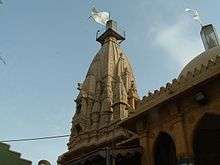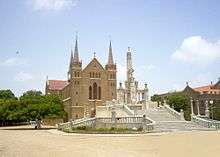Religion in Karachi
Religions in Karachi include Islam, Christianity, Hinduism, Sikhism, Buddhism, Zoroastrianism and others. According to a 1998 census of Pakistan, the religious breakdown of the city is as follows:[5] Muslim (96.45%), Christian (2.42%), Hindu (0.86%), Ahmadis (0.17%) and other (0.10%). Other religious groups include Parsis, Sikhs, Bahai, Jews and Buddhists. Of the Muslims, approximately 95% are Sunnis and 5% are Shi'ites. The Sunnis follow Hanafi fiqh while Shi'ites are predominantly Ithnā‘Ashariyyah fiqh, with significant minority groups who follow Ismaili Fiqh, which is composed of Nizari (Aga Khanis), Mustaali, Dawoodi Bohra and Sulaymani fiqhs.
Karachi was a small fishing village of Muslim Sindhi and Balochi people when Hindu merchants from Thatta established a trading port there in the early 18th century. When the British seized control of the offshore, strategically located island of Manora in 1839, Karachi had about 10,000 inhabitants, predominantly Muslim.[6] Thereafter, authorities of the British Raj embarked on a large-scale modernisation of the city in the 19th century with the intention of establishing a major and modern port which could serve as a gateway to Punjab, the western parts of British India, and Afghanistan. Britain's competition with imperial Russia during the Great Game also heightened the need for a modern port near Central Asia, and so Karachi prospered as a major centre of commerce and industry during the Raj, attracting communities of: Africans, Arabs, Armenians, Catholics from Goa, Jewish, Lebanese, Malays, Konkani people from Maharashtra, Kuchhi from Kuchh, Gujarat in India, and Zoroastrians[7] (also known as Parsees) - in addition to the large number of British businessmen and colonial administrators who established the city's poshest locales, such as Clifton. This mass migration changed the religious and cultural mosaic of Karachi.
104 years of British rule changed the demographic profile of Karachi from a Muslim town to a multicultural city. At the time of independence, nearly half the population of Karachi was non-Muslim. The independence of Pakistan in 1947 saw an influx of Muslim refugees from India fleeing from anti-Muslim pograms. Many of the Urdu-speaking and other non-Punjabi Muslim refugees that fled from various states of India settled in Karachi, giving the city a blend of predominantly Muslim culture.

Most Hindus and Sikhs of Karachi migrated to India from 1948 onwards - well after the establishment of Pakistan. Some 250,000 Hindus remain. Poor Hindus of Marwari and Rajasthani descent are concentrated particularly in Naraianpura and Lyari, while wealthier Sindhi Hindus live in Clifton and Saddar. Prominent temples include the Sri Swami Narayan temple on MA Jinnah Road, Daryalal Temple in Kharadar, and numerous temples in Narainpura including a Gujarati temple, a Marwari Temple, and a temple for the Karachi Sikh Sangat. Soldier Bazaar is home to a functioning Hanuman temple, and Ganesh temple. Two temples function in Clifton: the Samadha Dham and Sri Ratneshwar Mahadev Temple. In Civil Lines, the Sant Satram Dham functions on School Road near Karachi Cantonment Station. A property currently in dispute between Sikhs and Hindus also stands in Aram Bagh (formerly Ram Bagh), although the areas Ram Talao no longer exists, and Ramchandra temple no longer exists. Mithadar is home to the Bhagnari Shiv Temple and Devi Mata Temple. Manora is home to the Sri Varun Dev Temple. Despite most Hindus having left Karachi, a large number of streets continue to bear Hindu names, particularly in Aram Bagh, Mithadar, and Ramswamy.
The largest religious minority in Karachi are the Christians. The two major Christian ethnic groups are Goan Catholics and Punjabi Christians.[8] The Punjabi Christians are converts from the Hindu Churas and Mazhabi Sikh caste to Christianity during the British raj.[9]
The state religion in Pakistan is Islam, which is practiced by about 96-98% of the 195,343,000[10][11] people of the nation.[12][13][14] The remaining 2-4% practice Hinduism, Christianity, Ahmadiyya, Sikhism, Buddhism, Bahá'í and other religions.[14][15] Muslims are divided into two major sects: the majority of them practice Sunni Islam, while the Shias comprise an estimated 30%.[12][14][15][16][17][18] Nearly all Pakistani Sunni Muslims belong to the Hanafi Fiqh Islamic law school.[14] The majority of Pakistani Shia Muslims belong to the Ithnā‘Ashariyyah Islamic law school, with significant minority groups who practice Ismailism, which is composed of Nizari (Aga Khanis), Mustaali, Dawoodi Bohra, Sulaymani, and others.
See also
References
- "Religions in Pakistan". CIA World Factbook. Retrieved 2013-07-09.
- Curtis, Lisa; Mullick, Haider (4 May 2009). "Reviving Pakistan's Pluralist Traditions to Fight Extremism". The Heritage Foundation. Retrieved 31 July 2011
- a b c "Religions: Islam 95%, other (includes Christian and Hindu, 2% Ahmadiyyah ) 5%". CIA. The World Factbook on Pakistan. 2010. Retrieved 2010-08-28.
-
- ^ International Centre for Political Violence and Terrorism Research at Nanyang Technological University, Singapore: "Have Pakistanis Forgotten Their Sufi Traditions?" by Rohan Bedi April 2006
- Arif Hasan, Masooma Mohiburl (2009-02-01). "Urban Slums Reports: The case of Karachi, Pakistan" (PDF). Retrieved 2006-04-20.
- Karachi in 1889
- The Parsi Community in Karachi, Pakistan PRI's The World
- What was the past of Punjabi Christians?
- Alter, J.P and J. Alter (1986) In the Doab and Rohilkhand: north Indian Christianity, 1815-1915. I.S.P.C.K publishing p196
- 2014 World Population Data
- Information on other countries: http://hdr.undp.org/en/media/HDR_20072008_EN_Complete.pdf
- "Country Profile: Pakistan" (PDF). Library of Congress Country Studies on Pakistan. Library of Congress. February 2005. Retrieved 2010-09-01.
Religion: The overwhelming majority of the population (96.3 percent) is Muslim, of whom approximately 70 percent are Sunni and 30 percent Shia.
- "Population: 174,578,558 (July 2010 est.)". Central Intelligence Agency. The World Factbook on Pakistan. Retrieved 2010-08-28.
- "Pakistan, Islam in". Oxford Centre for Islamic Studies. Oxford University Press. Retrieved 2010-08-29.
Approximately 97 percent of Pakistanis are Muslim. The majority are Sunnis following the Hanafi school of Islamic law. Between 25-30 percent are Shiis, mostly Twelvers.
- "Religions". CIA. The World Factbook on Pakistan. 2010. Retrieved 2010-08-28.
- "Mapping the Global Muslim Population: A Report on the Size and Distribution of the World's Muslim Population". Pew Research Center. October 7, 2009. Retrieved 2010-08-28.
- Miller, Tracy, ed. (October 2009). Mapping the Global Muslim Population: A Report on the Size and Distribution of the World's Muslim Population (PDF). Pew Research Center. Retrieved 2010-08-28.
- "Pakistan - International Religious Freedom Report 2008". United States Department of State. Retrieved 2010-08-28.
Further reading
- The Political Ethnicity and the State of Pakistan
- "DHA wants SHC to shut down temple built on residential plot", The Express Tribune, 12 June 2014
